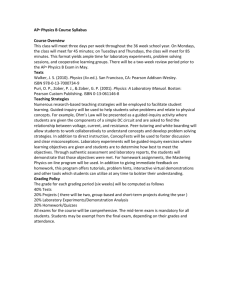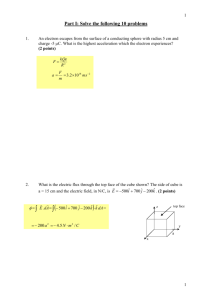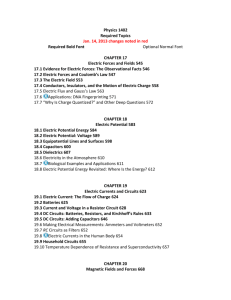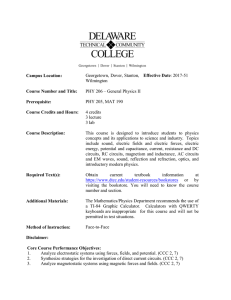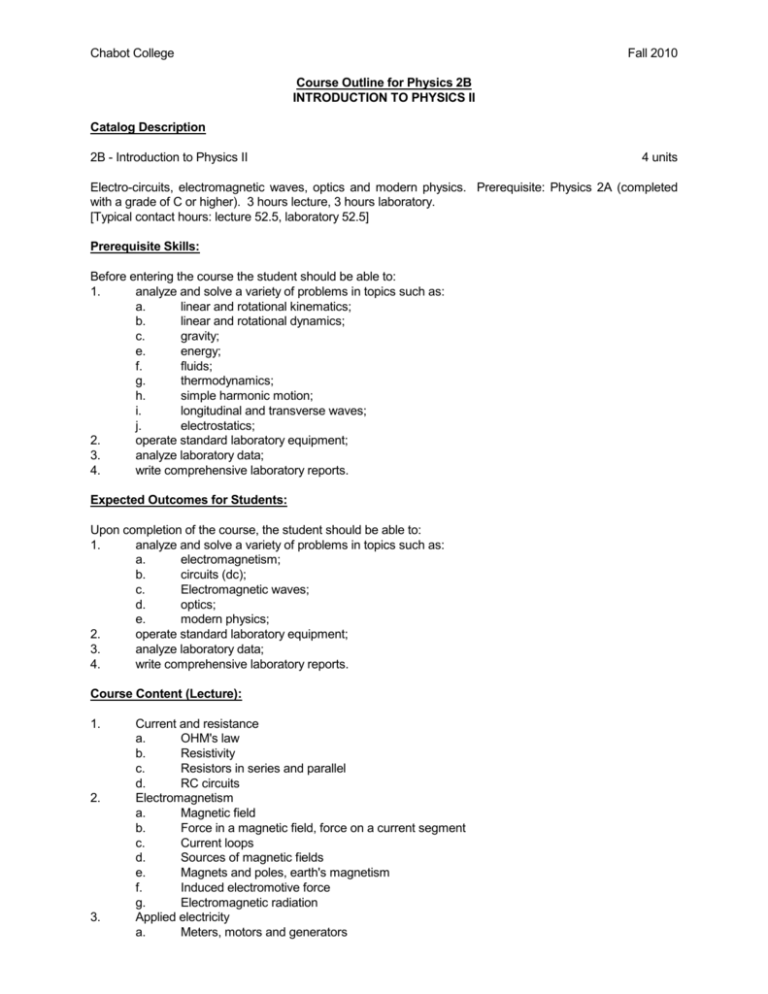
Chabot College
Fall 2010
Course Outline for Physics 2B
INTRODUCTION TO PHYSICS II
Catalog Description
2B - Introduction to Physics II
4 units
Electro-circuits, electromagnetic waves, optics and modern physics. Prerequisite: Physics 2A (completed
with a grade of C or higher). 3 hours lecture, 3 hours laboratory.
[Typical contact hours: lecture 52.5, laboratory 52.5]
Prerequisite Skills:
Before entering the course the student should be able to:
1.
analyze and solve a variety of problems in topics such as:
a.
linear and rotational kinematics;
b.
linear and rotational dynamics;
c.
gravity;
e.
energy;
f.
fluids;
g.
thermodynamics;
h.
simple harmonic motion;
i.
longitudinal and transverse waves;
j.
electrostatics;
2.
operate standard laboratory equipment;
3.
analyze laboratory data;
4.
write comprehensive laboratory reports.
Expected Outcomes for Students:
Upon completion of the course, the student should be able to:
1.
analyze and solve a variety of problems in topics such as:
a.
electromagnetism;
b.
circuits (dc);
c.
Electromagnetic waves;
d.
optics;
e.
modern physics;
2.
operate standard laboratory equipment;
3.
analyze laboratory data;
4.
write comprehensive laboratory reports.
Course Content (Lecture):
1.
2.
3.
Current and resistance
a.
OHM's law
b.
Resistivity
c.
Resistors in series and parallel
d.
RC circuits
Electromagnetism
a.
Magnetic field
b.
Force in a magnetic field, force on a current segment
c.
Current loops
d.
Sources of magnetic fields
e.
Magnets and poles, earth's magnetism
f.
Induced electromotive force
g.
Electromagnetic radiation
Applied electricity
a.
Meters, motors and generators
Chabot College
Course Outline for Physics 2B, page 2
Fall 2010
4.
5.
6.
7.
8.
9.
10.
11.
b.
Back emf, eddy currents
c.
Transformers, impedance in coil and capacitor
d.
Thermoelectricity
e.
Electromagnetic waves
Geometrical optics
a.
Huygens' principle, refraction and reflection
b.
Total reflection
c.
Ray tracing, thin lenses and mirrors
Wave optics
a.
Corpuscular theory of light
b.
Interference, the grating
c.
Diffraction by a single slit
d.
Applications of interference, Michelson's interferometer
e.
Polarization
f.
Double refraction and optical activity
Applied optics
a.
Camera
b.
Human eye, physiology
c.
Magnifier, microscope, telescope
d.
Spectroscope
e.
Description of laser and its applications
Modern Physics
a.
Viewpoint of the classical physicist
b.
Michelson-Morley experiment
c.
Discoveries at the close of the nineteenth century
d.
Einstein and special relativity
The outer atom
a.
Charge of the electron, electron mass
b.
The photoelectric effect
c.
Emission and absorption spectra
d.
X-rays, the Compton effect
e.
Duality of light and matter
f.
Heisenberg's uncertainty principle
Atomic physics
a.
Bohr theory
b.
Debroglie waves
c.
Quantum mechanics
The nucleus
a.
Nature of radioactivity, discoveries
b.
Nuclear atom
c.
Nuclides, stable and unstable, natural and artificial
d.
Experimental techniques, transmutations
Applied nuclear physics
a.
Uses of radioactivity
b.
Particle accelerators
c.
Fission and fusion
d.
High-energy physics, cosmic rays
Chabot College
Course Outline for Physics 2B, page 3
Fall 2010
Course Content (Laboratory):
1.
Laboratory experiments, simulations, and activities exploring the lecture content that may include the
following concepts:
a.
Currents and Ohm's Law
b.
DC circuits (Parallel and Series Circuits, RC Circuits)
c.
The magnetic force and field (Earth’s magnetic field)
d.
Ampere's Law
e.
Electromagnetic induction (Motors and Generators)
f.
Alternating current circuits (RLC circuits)
g.
Maxwell’s Equations and EM Radiation
h.
Light & Radio waves (Speed of light, Microwaves)
i.
Reflection & refraction (Basic Optics of lenses and mirrors, Telescopes, Microscopes)
j.
Interference
k.
Diffraction
l.
Polarization
m.
Atomic physics ( Emission and absorption spectra)
2.
Experimental Technique,
Error Analysis.
Manual
and
Computerized
Collection
and
Analysis
of
Data,
Methods of Presentation:
1.
2.
3.
4.
Lecture-discussion
Problem solving
Demonstrations
Laboratory experimentation
Assignments and Methods of evaluating Student Progress:
1.
Typical Assignments
Subject to instructor discretion:
a.
Weekly homework/question set: 10+ discussion and/or numerical problems taken from the
textbook and online homework systems. Example: A rectangular loop of wire lies in the
same plane as a long straight wire. As you can see, the long wire is parallel to two of the
rectangle’s opposite sides . The loop lies in the lower half of the plane below the long wire.
There is a current of 2.5 (A) in both the wires. The wire in the rectangular loop flows
counterclockwise. (a) What is the direction of the magnetic field due to the long wire at all
points on the lower half of the plane? (b) What is the magnitude of the net force on the
rectangular loop? (c) What is the direction of the net force on the loop? (d) What is the
magnitude of the loop’s magnetic moment? (e) What is the direction of the loop’s magnetic
moment? (f) Redo the problem in the following way. Suppose the current in the long wire
flows in the same direction and the current in the rectangular loop initially is zero. Suppose
the current in the long wire increases in time. What direction does the induced current flow in
the rectangular loop, clockwise or counterclockwise? Explain
b.
Laboratory reports (individual and group), including computer-based data acquisition and
analysis.
Example: Using a metal Slinky™, and Vernier™,Magnetic Field Sensor,
determine the relationship between the magnetic field and the current in a solenoid, and the
relationship between the magnetic field and the number of turns per meter in a solenoid.
Study how the field varies inside and outside the solenoid. Determine the value of µo, the
permeability constant.
c.
Written assignments that encourage critical thinking and writing skills by including essays
which involve analytical reasoning; Special exercise worksheets; computer simulations and
Chabot College
Course Outline for Physics 2B, page 4
Fall 2010
d.
2.
tutorials; individual and group activities, research papers, long-term individual and group
projects. Possible example: Research an application of physics related to a topic from the
class, and write a 5+ page paper, including at least 5 current outside references.
Participation in email and web-based instruction, discussion, homework assignments,
and tutorials, including web-based research on topics dealing with physics and its
applications to technology
Methods of Evaluating Student Progress
a.
Quizzes
b.
Examinations
c.
Written Laboratory reports (individual and group) based on the Physics Department
Laboratory Standards and graded on criteria that may include the following:
1.
Description of experimental procedures
2.
Completeness of data collected
3.
Quality of data collected
4.
Computational precision and accuracy
5.
Accuracy and precision of experimental laboratory results
6.
Proper use of symbolic notation
7.
Quality of analysis of scientific principles explored
8.
Quality of narrative explanations and reasoning
9.
Representation of data in tables or diagrams
10.
Evaluation of the experiment overall, including accuracy and error
d.
Midterm examinations
e.
Final examination
f.
Research papers
g.
Student projects
Textbook(s) (Typical):
Physics, Principles with Applications, Giancoli, Pearson/Addison Wesley , 2009
Special Student Materials:
None.






